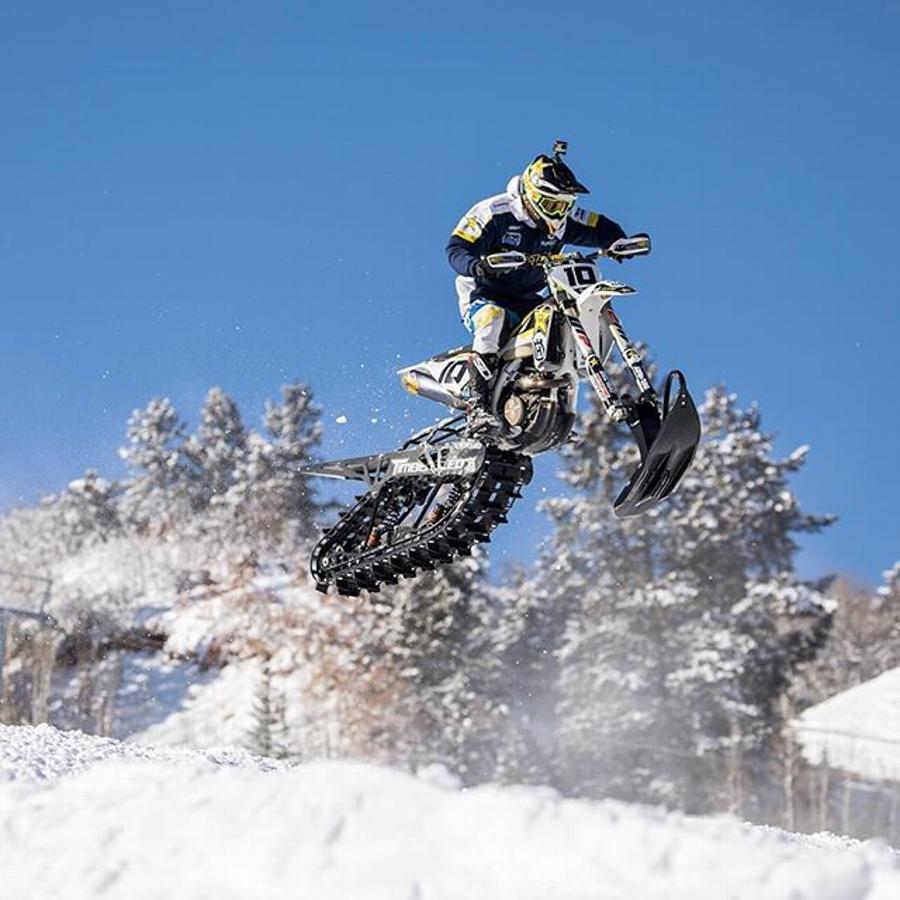Table of contents
ToggleThe Snow Bikes Are Coming
The snowmobile's little brother is poised to seize the slopes.

Photo : Timbersled
The bike is narrow, but stable enough that I can easily rest my feet on the pegs and balance without moving. The first time I give it some gas, I stall. On a second try, as I get to the end of a straightaway, I struggle to turn and nearly run over my instructor. But by lap number three, I’m in third gear, spraying snow as I carve around turns, and hooting like an idiot. How had I never tried this before?
You’d be forgiven if you’ve never heard of snow bikes until now, but that won’t last long. After languishing in big brother snowmobile’s shadow, snow bikes are finally having their moment. Basically just dirt bikes with a tank-like tread system replacing the rear wheel and a ski replacing the front wheel, they are smaller, more nimble, and a lot cheaper than snowmobiles. It’s a combo of features that makes them poised to become the dominant motorized snow machine for pure recreation. It also helps that they’re a whole lot of fun, even for first-timers.
If there’s one main barrier to entry, it’s that this is something of a DIY job for now. If you want to buy a snow bike, what you’ll really be getting is a conversion kit that turns your standard dirt bike into a snow machine. These kits are made by a variety of companies and when you buy one you also get mounting hardware for your specific dirt bike, be it Honda, Yamaha, Kawasaki, or what have you. As long as your dirt bike was born in the 90s or later, there’s a good chance you can find a kit. Conversion will take a little bit of work, but it offers a huge added bonus: can ride your dirt bike all summer, then, when the snow starts coming down, you swap in the track and ski and can keep riding all winter. Once the snow melts you just swap the wheels back in.
“Terrific,” you might say. “I’ve always wanted a snowmobile!” Think again. These are completely different beasts. Snow bikes, unlike their broader and heavier cousins, are narrow, light, and much easier to turn, which lets you to go where snowmobiles simply can’t, cutting your own lines through dense trees. Snowmobiles are notoriously lousy for side-sloping (sliding sideways instead of going forward cutting across a steep slope). On a snow bike, because you’re on just one ski and one tread, you remain upright like you would if you were mountain biking. The setup also enables you to carve your way down very steep terrain, as if you were on a snowboard.
All that said, words do not quite suffice as a means of describing what these machines are capable of. As a visual aid, I suggest you watch this:
The concept of the snow bike is far from new. Prototypes for motorcycles with two rear wheels that could accommodate tracks go as far back as the 1920s. In WWII, both France and Germany got into the game, attempting to make a lean machine that could be used for warfare in the rough terrain and snow of the Alps. In the 1930s, the American company J.E. Love developed the Shrew snow cycle, which was the first snow bike that had a ski in the front on shocks. They made between 500 and 1000 Shrews but they had some problems with overheating engines. They were also extremely difficult to turn but very easy to tip.
That was about as close to success as snow bikes came for a while, though there were many iterations by many manufacturers through the 1950s and 60s. Popular Mechanics even featured a kit from a company called “Snow Job” in 1973, but the unit was wide and awkward, especially considering its $778 pricetag, which is more than $4,300 adjusted for inflation. There was a similar failure in 1977 when the U.S. military commissioned Chrysler to develop what would be called the Sno-Runner. Ultimately the government decided to pass on it because it would get stuck in deep snow, so Chrysler went public with it in 1979. It was advertised as a “light utility mountain vehicle” and it was showed off at ski resorts around the country. They were sold for $900 and never found a market, so they were pulled by 1982.
But today, after a few more decades of technological advancement, these nimble snow machines are flying off the shelves, building an ever-growing tribe of devotees, and even showing up on the biggest stages in snow sports. While a handful of companies now make snow bikes, the basic design has mostly stabilized. They all have a ski up front and a track in the rear with roughly 20 inches of suspension travel, giving the bikes a very cushy feel even on uneven terrain. Companies like Moto Trax, Yeti Snow MX, Sno Ripper, and CMX all have followings, but the 800-pound gorilla in the market, and the one most responsible for the snow bike renaissance, is the Idaho-based company Timbersled which revitalized the age-old design.


